If you’re a B2B marketer, it means the target customer for your company’s product or service is another business rather than an individual consumer — so by definition, B2B marketing should be focused on acquiring accounts, rather than individual contacts. Because of this, B2B marketing is inextricably linked to Account-Based Marketing (ABM) and Account-Based Selling (ABS) strategies. But what do these terms mean, and what does it actually look like to implement and manage ABM and ABS programs? We’re here to demystify it for you, and provide you guidance along the way based on decades of experience and hundreds of clients we’ve successfully supported with account-based marketing and sales strategies.
An Account Based Marketing strategy identifies the firmographic characteristics of your ideal customers, and uses this information to identify a ‘total addressable market’ (TAM). Oftentimes, ABM strategies will create several tiers of companies that meet the criteria of a total addressable market, in order to differentiate what tactics will be used, and the type of resources, to reach the most desirable parts of the TAM.
![]() For instance, if you think about a Total Addressable Market as a set of concentric circles, at the center of that diagram is your most desirable client — those with the highest likelihood of conversion, the most profitable, or easiest to convert. The next concentric circle would be slightly less desirable, but still meeting your broadest criteria, and so forth.
For instance, if you think about a Total Addressable Market as a set of concentric circles, at the center of that diagram is your most desirable client — those with the highest likelihood of conversion, the most profitable, or easiest to convert. The next concentric circle would be slightly less desirable, but still meeting your broadest criteria, and so forth.
Typically, a marketing and sales team would work together to determine who is responsible for relationship building for each of the tiers within the TAM. Marketing teams often take the lead on the outer rings of the TAM, while strategic sales teams may take the innermost part of the TAM.
An Account Based Selling (ABS) strategy means you’re pursuing your highest value accounts with a personalized one-to-one approach that closely ties the company’s value proposition to the prospect’s needs.
Using the illustration above, these high-value accounts are those in the very center of your concentric circles of the TAM.
Having created hundreds of account based campaigns for B2B clients, we’ve determined four principles that predict a successful outcome.
MarketLauncher’s guide, Take An Account Based Selling Approach to Growing Your Revenue, further expands on these principles.
If you’re looking for the best possible results, it’s a good idea to implement Account Based Marketing and Account Based Selling programs together. Why? Alignment between your teams helps ensure that the strategy is implemented effectively and efficiently — and you’re all on the same page about who owns what accounts, what leads and why.
When implementing these strategies together, it could look like this:

The marketing portion of your account based strategy kicks in at the top of the funnel, to build awareness with your TAM and provide the necessary ”air cover” to make your outbound sales efforts more effective.
Successful marketing tactics include:
Successful sales tactics include:
With an effective, integrated campaign, leads are successfully handed off from marketing to sales. Seamless integration between the two helps ensure no leads are left dormant and that meetings with the best prospects are secured for your sales team at a high velocity.
If you’re executing ABM and ABS in an integrated way, you can expect the highest chances of success, especially compared to executing either method on its own. Check out a few case studies from clients where we’ve successfully supported both efforts:
The Company founders built a valuable product for accountants of SaaS companies, who have the complex job of recognizing revenue. However, they were challenged in getting the platform in front of their target buyers and generating leads for their sales team. We worked with the Company team to make some initial improvements to the website, and then built creative ad campaigns to generate awareness for the product, and then drive them to a free trial. We used remarketing campaigns to stay in front of people who expressed interest. The ads we created generated dozens of new leads each month, which were passed on to an outbound appointment setting firm, to vet and gauge interest. The resulting discovery calls led to multiple opportunities per month and a steady cadence of new customers. The campaign allowed the Company to demonstrate return on investment and scale their lead generation program. Within six months, the Company had a successful acquisition offer from the industry leader in the space.
The Company had a proven technology solution for banks that need to implement Account Opening Fraud protection. This was one of the Company's first new product marketing campaign implemented on a global scale. They chose Beacon Digital Marketing to bring the campaign to life from start to finish, trusting our digital marketing experience and creative chops to make their first global campaign a success. To execute our campaign, we ultimately decided on a direction that led to additional asset creation, including video, landing page, display ad creative, and content creation in both English and Spanish. Over 3 months, we drove 1,050 MQLs, beating the Company's total goal of 1,000, at a cost per lead of $85, which was 78% lower than the goal of $400. Our leads were shared with an outbound appointment setting firm, who followed up to schedule meetings with the Company's sales team. The campaign delivered multiple closed/won deals each month it ran.
The good news is that you don’t have to invest in a lot of expensive tools to execute ABM and ABS strategies — despite what many platform companies may make you think. There are, however, a few necessary components that we find critical:
LinkedIn. Having a company page is the first step to being able to run targeted ads on LinkedIn that reach your target audience. LinkedIn is one of the few platforms that allow you to target people based on their company associations as well as the demographic details of their associated company. While LinkedIn Sales Navigator isn’t necessarily required, it can be helpful for your sales team to research and track their assigned accounts, and to find personalized information for more effective one-to-one communication.
Contact Database. Whether it's ZoomInfo, SalesIntel, or a source more specific to your industry, a database that helps you identify the decision makers and budget holders within your TAM, as well as their contact information, is critical to your success. If you’re working with an agency, you may find that contact database research is included as part of the program, but you’ll want to be sure to understand who owns the contact information when all is said and done. (Some companies may only pass along contact information for those who book a meeting, rather than giving you the full contact information for everyone they identify within your TAM).
Email Marketing Automation Platform. If you’re going to be sending out emails, whether they are one-to-one emails from your sales team, or automated nurture programs from your marketing team, you need to understand who within your TAM is engaging and demonstrating interest. We highly recommend HubSpot as the platform of choice for these efforts due to its ease of use, speed of implementation, and integration with either HubSpot CRM or Salesforce CRM.
CRM. You simply can’t execute an Account Based campaign strategy without a customer relationship management platform (CRM) to centralize and track your efforts. Typically our clients leverage either Salesforce or HubSpot CRM, but others like ZOHO CRM or Microsoft Dynamics, could also be used. If you’re early in your company or product marketing journey, you may not have a CRM yet, in which case companies like MarketLauncher and Beacon Digital can implement a CRM for you, and help optimize your CRM for Account Based campaign execution.
If you know you are ready to implement account based campaigns to drive growth for your business, you’ll need the right team to create the strategy and help bring it to life. While you can certainly implement campaigns effectively with an in-house team, you may not have the luxury of time. When you need to ramp up quickly, you can leverage the highly experienced teams at MarketLauncher and Beacon Digital Marketing, who specialize in launching and accelerating growth for high-tech firms. Contact us today to discuss the specifics of your product or service.
This blog was coauthored by Whitney Mitchell, CEO & Founder of Beacon Digital Marketing, and Lara Triozzi, CEO & Founder of MarketLauncher.




